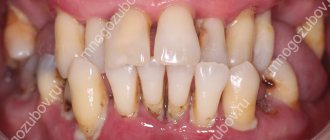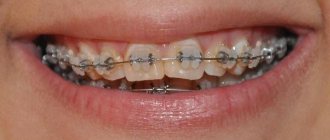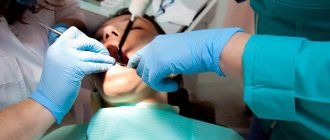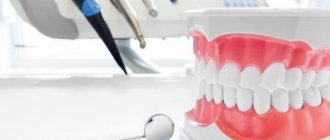707
The development of a cyst located on the root of a tooth causes a lot of negative symptoms, which complicate the comfort of a person’s life, and can cause dangerous complications such as an abscess, osteomyelitis or sepsis.
Therefore, in order to prevent complications, the dentist most often decides to remove the tooth.
The implantation method allows you to restore the integrity of the dentition without grinding down adjacent teeth.
It will help restore maximum functionality of the dental unit, while maintaining the aesthetics and natural whiteness of the smile.
Implantation methods after tooth extraction
Dental implantation after extraction is carried out according to two protocols:
- One-stage - involves installing an implant immediately into the socket of the extracted tooth. There are techniques that allow not only the installation of an implant, but also the fixation of a crown on it.
- Delayed - requires complete healing of the hole and restoration of bone tissue after removal. The bone is restored in 2-5 months depending on the health of the patient. Only then is implantation carried out.
Consequences of implant removal
- The procedure for dental implantation and the consequences of their use are not included in the register of services provided under the health insurance policy in the Russian Federation. That is, implants are installed only on a commercial basis.
- Therefore, the structure has to be replaced free of charge in the same clinic where the installation procedure was previously carried out.
- Loud promises from the manufacturer are replete with terms such as “lifetime warranty.” However, if there is a reason for removal and reinstallation, the manufacturer will try to relieve itself of responsibility and will refer you to the implantologist who installed the structure.
- If implantation leads to complications, then you can save on treatment only if one condition is met. Namely, the inflammation that has arisen must be eliminated by a doctor from the same commercial clinic.
- The desire to transfer to another medical institution to treat complications will cost three times more than installing a new implant.
Summarizing all these nuances, each patient should take the choice of a doctor and clinic very seriously where they will provide the necessary service. It is important to discuss options for solving possible complications in advance at the medical institution. And it is desirable that this is not just an oral conversation, but is specified in the contract or obligations of the clinic providing dental implantation services.
When it is possible to perform implantation - the doctor chooses after a complete diagnosis
It is necessary to study the condition of the bone tissue, its size and density. Based on the results, the doctor makes a decision - delayed or immediate implantation. Our Center is equipped with diagnostic equipment, so results can be obtained within 15 minutes . But this is only a preliminary assessment; the final decision is made after tooth extraction.
Levin Dmitry Valerievich
Chief physician, Ph.D.
Methods used
Dental restoration through dental implantation can occur in one or two stages. Each of them has its pros and cons, but after removing the cystic lump, preference is given to the second method.
Implantation using a one-step method
This technique has 3 varieties, which are:
- Instant. The orthopedic structure is installed directly into the hole at the site of the extracted tooth. After this, the gingival surface is sutured, and after complete healing, a crown is installed.
- Accelerated. In this case, the patient receives an implant by puncturing the gums. This technique is used when the hole has already healed after tooth extraction. This technology refers to minimally invasive operations, but there are a sufficient number of contraindications.
- Immediate load. The technique allows you to create a load on the dental unit by installing a temporary crown.
The procedure is performed using a one-step method in compliance with the following algorithm of actions:
- After the initial examination, the material of the crown to be installed is selected. The doctor prescribes an x-ray, and for more information the patient needs to undergo a computed tomography scan. If necessary, a blood test (general and biochemical analysis) is prescribed.
- To reduce pain, the operation is performed using local anesthetics. After their management, the required incisor or molar is completely removed.
- A hole is drilled in the resulting hole to install the future artificial root. At the same time, in order not to overheat the bone, the manipulation is carried out with constant cooling with saline solution.
- After installation of the intraosseous system, the gums are sutured. In some cases, a former is installed, followed by placing an abutment on its surface and installing a temporary crown.
This installation technology has a number of advantages:
- short treatment period and low tissue trauma;
- relatively short rehabilitation period;
- minimum number of dental visits;
- high degree of comfort, since the painful procedure is performed once;
- quick elimination of a cosmetic defect.
But if a tooth is removed with the presence of a cystic capsule, then most practitioners do not recommend this technique. This is due to the following problems:
- a large volume of the cyst can negatively affect the condition of bone tissue;
- the chance of rejection increases, since after removal of the capsule, infection of the bone tissue is possible;
- incomplete removal, fragments and particles of the capsule can cause cyst recurrence.
What is the purpose of bone tissue augmentation in dentistry, and how relevant is the technology?
In this publication we will talk about the purpose of a temporary abutment.
Here https://www.vash-dentist.ru/implantatsiya/metodiki/kompleksnaya-vseh-zubov.html we will discuss the pros and cons of complex dental implantation and the price of specialist services.
Immediate load
This technology is a variation of the one-step method. It is carried out according to the same principle.
Types of prosthetics with immediate loading on the orthopedic structure.
| Serial number | Variety | Short description |
| 1 | InstanTeeth | It is used when no more than 4 teeth are missing. In this case, 1 implant is implanted for each unit. |
| 2 | Аoll-n-4 and Аoll-n-6 | In the first case, the bridge-like connection is attached to 4 implants, in the second, the stability of the product is ensured by 6 artificial roots. In some situations, the titanium end rods are installed at an angle of 45 degrees. |
| 3 | Smile-at-once | Using this technology, you can install from 8 to 14 dentures at once. Subsequently, they are fastened together with a special beam, forming the basis for a permanent structure. |
You need to know that most leading dentists do not recommend using this technique after removal of the cystic capsule. This is due to the fact that in some cases it takes up to six months for the wound surface to completely heal.
Two-step method
After removal of the cystic formation, it becomes necessary to fill the gap in the row. In this case, preference is given to a two-stage technique.
Despite the long duration of its implementation and the difficulties that arise during the rehabilitation period, it has the following advantages:
- performed after complete healing of the soft tissue of the gums;
- provides a high level of aesthetic performance;
- the use of titanium alloys is not an allergen for the patient;
- allows you to avoid the installation of a construct in case of repeated cyst recurrence.
The sequence of this technique occurs in compliance with the following steps:
- Preparation takes from 2 days to 3 months. During this period, the patient needs to undergo tests, take x-rays, and, if necessary, undergo a consultation with specialized specialists. In addition, the oral cavity is sanitized.
- Osteoplasty is performed according to indications when the long-term absence of incisors or molars has led to bone degeneration. This period can be from 3 to 4 months.
- System installation. On average, it takes about half an hour to implant one titanium rod. During the operation, a local anesthetic is used to relieve pain.
After cutting the soft tissue of the gums, an opening is created (using a bur). Installation of the structure is completed by placing a special membrane and plug on the top, followed by application of suture material.During this stage (approximate duration 3 months) maximum load limitation occurs.
- The former is installed after removing the plug.
The period of wearing it lasts about 2 weeks. After this period, a cushion is formed around the future crown. Removal of the former occurs along with fixation of the abutment. - The final prosthetics takes from 1 to 2 days, with the installation of a crown from the selected material using cement fastening.
In the video, watch how basal implantation is carried out after the removal of a tooth with a cyst.
Indications and contraindications for immediate implant placement
Indications
- Mechanical damage to the root - fracture, dislocation
- Restoration of frontal units
- Therapeutic treatment did not bring results
- Sufficient bone volume
- No contraindications
Contraindications
- Deficiency, looseness of bone
- Inflammation at the root apex
- Enlarged socket after removal
- Inflammatory processes of the oral cavity, gum pathologies
- Reduced immunity, systemic diseases
- Pregnancy, breastfeeding period
How to do dental implantation immediately after extraction
After a tooth is removed and an implant is immediately placed, the process of osseointegration occurs faster. The hole with the artificial root begins to heal, the blood clot turns into bone tissue that surrounds the implant in the early stages of healing. This promotes accelerated osseointegration of the implant with the jawbone, ensuring reliable fixation and stability.
Stages:
Diagnostics
Full diagnostics, choice of design in the absence of contraindications.
Tooth extraction, artificial root installation
Local anesthesia or sedation is used. A bed is formed in the hole, an implant is installed, and the space around is filled with osteoplastic material. After the procedure is completed, the gums are sutured. A temporary removable prosthesis is installed. Engraftment lasts 4-6 months.
Prosthetics
After osseointegration of the implant with the jaw bone, the gum is opened, and a gum former is fixed to the implant for 10-14 days to create a gum contour. Then the former is replaced with an abutment, and a crown made from the impression is installed.
In rare cases, it is possible to fix the crown to the implant immediately after its installation. At the same time, the crown is removed from the bite so that the implant does not move during chewing. This method is recommended for the anterior parts of the jaw in order to quickly restore the defect. Not suitable for lateral use due to active chewing loads.
Execution technique
Before proceeding with the removal of diseased teeth and emergency implantation, it is necessary to undergo diagnostics by specialized specialists who will confirm that the patient does not have dangerous diseases. Without medical certificates and test results, an experienced orthopedist will never undertake implantation.
A thorough examination of the oral cavity and the condition of the teeth is carried out. If necessary, the patient is treated for carious cavities and periodontal disease, and only after that they begin the procedure of removing the native root and installing a titanium one.
The process of installing the pin into the bone tissue is carried out under anesthesia. The orthopedist introduces a special mixture into the created hole, which will facilitate the implantation of a titanium pin. The abutment is attached to the implanted base after several weeks or a month, depending on the speed of healing of the damaged tissue.
Service life of implant parts
Then the specialist installs the crown on the titanium base of the prosthesis, which can be made from different materials based on a photograph of the patient’s jaw:
- Metal ceramics;
- Metal;
- Acrylic;
- Porcelain;
- Plastic.
The choice of material for the upper part of the prosthetic structure depends on the location of its installation and the level of chewing load, as well as on the financial capabilities of the person. For prosthetics of the last chewing molars, it is better to use metal-ceramics; porcelain or acrylic can be used in front.
Metal-ceramic crowns are considered the most durable and strong, which, if installed correctly, can last up to 20 years.
If the diagnostic process does not reveal diseases incompatible with such an operation, then there is no need to waste time with it. After removing a diseased tooth, an implant should be immediately placed in its place.
Advantages and disadvantages of one-stage dental implantation
pros
- One operation is performed, waiting time is reduced
- Simplified installation process
- Minimal loss of mucous and bone tissue after surgery
- If the technology is followed, the percentage of successful operations is 99.6%
Minuses
- Contraindicated in chronic inflammation, diseases
- Not performed if there is insufficient bone
- Strict rehabilitation period, frequent visits to the implantologist
For a favorable outcome, entrust the operation to a surgeon with extensive experience in this protocol.
Is it possible to place an implant if a tooth has been lost for a long time?
Whether it is possible to place an implant if the tooth was removed a long time ago is decided only by the surgeon after a complete diagnosis. Already 3 months after removal, the bone is so absorbed that it may not be enough to install an implant and augmentation will be required. The recommended implantation period is no later than 2-3 months.
In case of bone atrophy, osteoplasty is performed:
- Guided bone regeneration . Most often performed on the lower jaw, bone materials, biomembranes, and bone growth stimulators are used. It is used if the width and height of the patient’s bone is not enough for implantation. If bone tissue atrophy is insignificant, it is possible to perform NCR simultaneously with the installation of implants. Otherwise, it is carried out in a separate preliminary stage. It takes 3-4 months for the grafted material to fuse with the bone.
- Sinus lift. Intervention in the bone structure of the upper jaw in the area of the maxillary sinuses. Using instruments, tissue is punctured to raise the bottom of the sinus. The resulting space is filled with osteoplastic material. The operation can be closed or open. A closed sinus lift is performed for minor bone atrophy simultaneously with the installation of implants. Open - for moderate and critical atrophy in a separate stage.
Make an appointment with an implantologist
Price
The Center for Private Dentistry Dr. Levin provides a case payment system.
- When implanting Nobel Biocare PMC Select or Groovy, the cost includes the surgical stages, including the design model, surgery, anesthesia, and all necessary procedures. The price is indicated taking into account the preparatory stage.
- Removal is paid separately, the price includes surgery, inflammation relief, socket rehabilitation, consumables, anesthesia.
- The case for installing a metal-free zirconium dioxide crown includes all stages - impressions, manufacturing, installation.
- Sinus lifting and any bone tissue augmentation operations are paid separately.
Alternative options for tooth restoration after extraction
After removal, doctors recommend restoring the tooth in a short time. This is caused by bone tissue atrophy, which begins in the absence of chewing load, which complicates recovery in the future.
If for some reason the patient is not ready for implantation, alternatives can be offered:
- Bridge prosthesis. It is a non-removable structure of interconnected crowns. For installation, two supporting teeth are depulped (nerve removal, canal filling) and ground down for crowns. At the same time, the load on the support increases, mobility develops, which is why the bridge will need to be replaced. The bridge structure is not able to completely prevent bone tissue atrophy, but it prevents rarefaction, displacement, and curvature of the dentition. The rate of bone atrophy and the development of mobility depend on the patient’s health.
- Removable dentures . They represent a structure made of artificial gum with soldered crowns, attached to adjacent teeth with hooks. The supporting teeth are ground down if the fastenings are metal. The prosthesis has a range of mobility and requires careful care, since food particles can get under it. Removable dentures do not stop atrophy, but they do prevent displacement of adjacent units.
Implantation prevents all problems, including bone atrophy. An implant is an artificial root on which a crown is placed. Neighboring teeth are not ground down or damaged. The chewing load is maintained. The survival rate of dental implants is 98%. Implantation is considered the most reliable way to prevent bone resorption.
Why does my cheek sometimes swell after gum surgery?
Swelling after dental implantation is a normal reaction of the body to surgery . It is formed against the background of activation of the immune system due to damage to the gums and the introduction of a foreign body. Natural regeneration of soft tissues is accompanied by swelling in the area of the installed titanium rod. The type, size, and nature of swelling depend on the following factors:
- degree of tissue damage during surgery;
- compliance by the specialist with the surgical protocol;
- sterility conditions;
- quality of materials, medicines;
- patient compliance with doctor's recommendations.
At the stage of preparation for implantation, you need to inform the specialist about the presence of diseases that can increase swelling. To prevent complications, decongestant therapy will be carried out.
Dental expert opinion : “Implantation is a serious surgical procedure that requires cutting the gums and damaging the jaw bone. Considering the abundant passage of blood vessels in this area, swelling is an adequate reaction of the body. In 95% of cases it is not dangerous. If your overall health is normal, the swelling will subside on its own within a week, provided you follow the recommendations. If the body is weakened, the gums hurt or are inflamed, the swelling does not go away, then you will have to work hard to help restore the tissue. It is necessary to carefully monitor the condition of the oral cavity to avoid the development of complications. If problems arise, immediately contact your doctor so as not to worsen the situation.”











